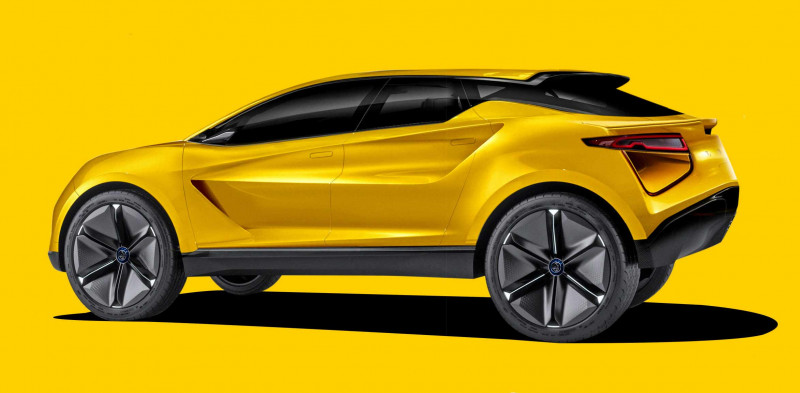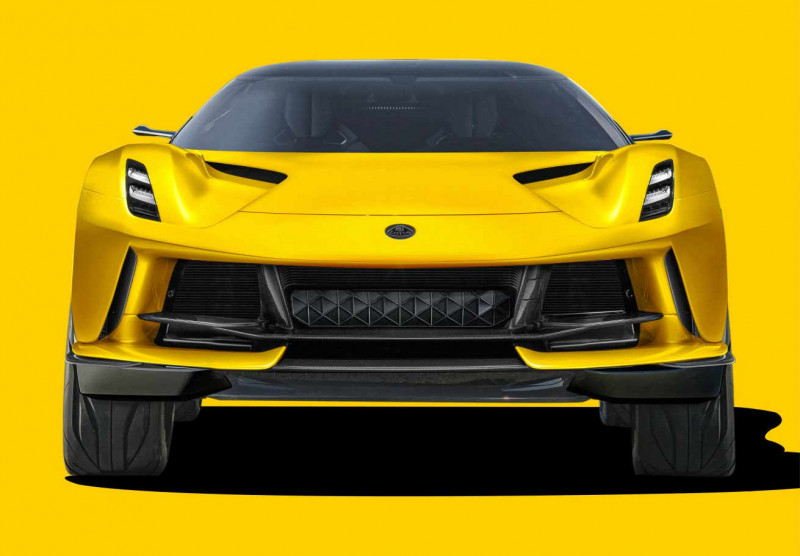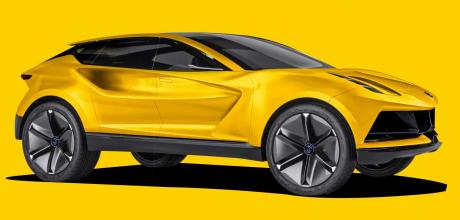The first Lotus SUV: secrets of Type 132
2022’s bravest new car is the imminent Type 132, which aims to take the essence of Lotus into electric SUV territory. Words Ben Miller. Illustrations Avarvarii.
LOTUS EXCLUSIVE! 2022’S ELECTRIC SUV: THE INSIDE STORY
The first Lotus SUV: secrets of Type 132
A Lotus like no other
If you made it to the 2021 Goodwood Festival of Speed you’ll know New Lotus has arrived. There the marque’s vast stand – a yellow and black monolith like a space station touched down in leafy Sussex – dominated the event, as did the car the crowds queued patiently to see and, crucially, to buy: the Emira. But exciting though the Emira is, as a lightweight sports car with a combustion engine it occupies extremely comfortable ground, for both Lotus and fans of its work. No, the first big test of New Lotus (in which Geely has owned a 51 per cent stake since 2017) will be the electric SUV, codenamed Type 132, set to be unveiled in the next couple of months. This, together with concept illustrations commissioned by CAR, is everything we know of this fascinating Lotus; a Lotus like no other.

Type 132 is a Cayenne-sized electric SUV with twin motors drawing power from underfloor lithium-ion batteries rated between 92kWh and a mighty 120kWh. An 800-volt architecture brings the promise of fast charging, while cutting-edge hardware and a standard-fit 5G router will work to futureproof the package via speedy over-the-air updates. This will be the first car on the Lotus Premium architecture, a platform able to accommodate wheelbases between 2889mm and 3100mm initially. Type 132 will be offered with two power outputs from launch; neither will be slow. Mention numbers like a handy 700bhp and 0-62mph in under 3.0 seconds to those close to the project and you get encouraging answers, particularly on the straight-line performance: ‘That would be a reasonable target to shoot for. Certainly, it’s technically possible with this package,’ says on insider.
‘This car is going to be rapid, as you’d expect from a Lotus,’ he continues. ‘And, of course, with an electric powertrain there’s no delay, either in the engine or the transmission, so the response is instant.’ As with the Evija hypercar, Type 132’s motors will be specified and tuned to deliver sustained acceleration.
The wild, overtly cab-forward silhouette calls to mind mid-engined supercars rather than any SUV rivals
‘The Lotus of SUVs’
‘The Lotus of SUVs’ smacks of marketing soundbite. But spend any time with the individuals working on Type 132, both in design and engineering, and you begin to suspect there might be something in it – that ‘The Lotus of SUVs’ might actually be both Type 132’s mission statement and its guiding light. This won’t – cannot – be a lightweight machine. But it might just look and feel like a Lotus.

One advantage Hethel has as it seeks to create an authentically Lotus SUV is that its dynamic DNA has never been about rock-solid suspension. For Lotus, ride and handling aren’t mutually exclusive. Its cars are sporty but not punishingly so. Type 132 will follow their lead, which bodes well. The Lamborghini Urus sits largely unchallenged at the sporty end of the luxury SUV spectrum (BMW is readying its XM plug-in hybrid, and Ferrari its Purosangue), and Lotus is convinced its flair for dynamics, aerodynamics, performance and design – not to mention Type 132’s bold all-electric powertrain – will give it a competitive edge.
Key to becoming a believer is addressing a couple of misconceptions. The first is that Lotus is new to SUVs. Wrong. While this will be the first SUV with a Lotus badge, it’s by no means the first Lotus has worked on. ‘An SUV held no fear for us because we’re experienced with SUVs through Lotus Engineering,’ explains a source. ‘So, while Type 132 does represent many firsts – it’s the first volume electric Lotus, the first Lotus with more than two doors and the first Lotus SUV – none of those are really firsts for us. It’s the same with electrification: we’ve had charge points outside Hethel for over a decade now. Everyone here was very comfortable with the brief of creating an electric Lotus SUV.’
The second misconception is that, because New Lotus and Type 132 are global, the level of control Hethel might be able to exert over the project will inevitably be diminished; the car’s essential Lotus-ness diluted. Not so, says Lotus. While the car will be built in China, in a now all but complete purpose-built factory (the other key site in Wuhan is the £900m Lotus Technology R&D campus), the UK is at the heart of the project, defining, developing and designing the car.
Our man on the inside: ‘The opportunity here is to make sure that under Geely ownership we make cars that are true to the Lotus brand. That’s the mission, and it’s pushing us to create a really exciting portfolio of cars. Type 132’s core platform and all the elements crucial to how the car drives were defined at Hethel, by the same people who’ve proven themselves experts in sports cars.’
Shift your perspective and the resources behind Type 132 start to look like something of a global dream team, with the car designed, defined and developed in the UK and engineered in Germany (at a new centre in Frankfurt, under chief engineer Franco Cimatti, formerly of Ferrari), with funding, expertise and state-of-the-art EV know-how from China and safety and assist systems from Geely’s centre in Sweden.
Not light. But right
If you’re clinging to the idea that Type 132 will do for SUVs what the first Elise did for sports cars – prove once and for all that, when it comes to weight, less really is more – it’s time to get real. Lotus argues that a sub- 1700kg E-segment battery-electric SUV just isn’t possible, certainly not with the required attributes in terms of range and performance.
Expectations on quality and technology are also higher than they are in sports cars. But Lotus is confident its electric SUV will be competitive in the class (the Tesla Model X is a 2.5-tonne car), and emphasises that it’s evaluating the weight implication of every piece of technology it considers. No range figures have yet been offered, though we’re told 300 miles is being considered a minimum. So inextricably linked are range and battery mass that Lotus will lean towards a lower weight and increased driving enjoyment over a headline range figure.
Crucially, given plans to offer the car with and without chassis systems like active anti-roll control, the fundamentals look promising. The base set-up includes double-wishbone suspension front and rear, torque vectoring by brake (active torque vectoring may follow) and air suspension as standard, a key weapon in any performance SUV’s armoury. Optional active anti-roll control, carbon-ceramic brakes (here as much for the unsprung weight saving as their fade-free performance) and rear-wheel steering promise to elevate the car’s dynamics yet further. Rear-wheel steering should bring real turn-in agility, while active anti-roll bars will help control the car’s mass (substantial, and carried relatively high) without ruining the ride quality. While active anti-roll systems can feel quite artificial, Lotus insists Type 132 will feel natural and intuitive.
Inside Type 132
As one of the images teased last year confirmed, Type 132 will feature a lidar system (more reliable, Lotus says, than a combination of radar and cameras) for semi-autonomous drive capability. Implementing this – together with the raft of other tech required on a car of this style – in an authentically Lotus way is key to Type 132’s success.
Lotus talks of balancing the differing appetites for technology globally. While demand for new technology is high in China, for example, it reckons there’s ‘pushback on excessive tech’ in some other regions. The result is ‘a compromise in terms of technology versus Lotus design simplicity’.
‘You’ve seen how good the Emira’s interior is in terms of quality and technology – it’s a big step for Lotus,’ explains a member of Type 132’s design team. ‘This will be another step again. We’ll have ultra-competitive – if not next-generation – levels of technology in the car and, thanks to the EV architecture, we’ve a lot of space too. The cockpit is a very welcoming place, it’s generous, but still with sports-car characteristics. But really it’s all about the technology. That’ll be the big surprise when you see it. Key for us is that you’ll have the choice. You’ll be able to really immerse yourself in the tech. Or, if you want to be completely focused on the driving experience, you can choose to make a lot of it disappear.’
One intriguing system in development is what Lotus calls ‘track-level intelligent drive’, a ‘new technology to assist drivers to perform as well as an F1 driver on track’. Given both the quality of the driving team at Lotus and its newfound R&D might, a system that lets even mortals exploit a car as potent as Type 132 might be the project’s single most exciting aspect.
Design: a high-rise Evija
Team Type 132 isn’t blind to the contradiction at the heart of this project – that Lotus is a performance-focused company with light weight as its core ethos. On the face of it, Type 132 is a product in conflict with that. But so too, to an extent, is the Evija, and that car is at least beautiful. The SUV borrows heavily from the hypercar, with streamlined forms and the same striking ‘porous’ design philosophy; myriad ducts and vents to help make the body appear lighter on its wheels than it actually is.
‘It’s about emphasising the areas in which this car can relate to what Lotus has done traditionally,’ continues our design insider.
‘On the exterior that’s meant focusing on the aerodynamic capability, unusually so for a car in this category. We’ve tried to make this high-level aerodynamic functionality explicit, and that’s given us something more exciting than you’d expect from an SUV from a conventional brand, and therefore something appropriate for Lotus.’
Picture a bigger, more muscular Evijainspired body (Geely founder and chairman Li Shufu is a huge fan of the Evija) sitting on vast 23-inch wheels and you won’t, we’re told, be too far wide of the mark. And if that sounds dramatic, that’s deliberate. ‘In the past, Lotus cars have often been very dramatic; beautiful products, yes, but bold statements too.’ The team’s confident Type 132 will look like nothing else, with far less visual heft to it than rival SUVs of a comparable size. Lotus also talks of the car having a ‘super-sport stance’ and ‘sculpture more extreme than you’d expect on an SUV’.
The silhouette is certainly wild, calling to mind mid-engined supercars rather than any E-segment SUV rivals. It is overtly cab-forward, with a nod to mid-engined architectures (logical, really, given Lotus has been synonymous with the mid-engined layout for decades now). These proportions, made possible by the electric powertrain, also indicate that there’s no great big V8 or V12 under the bonnet. Type 132 is all about a new generation of zero-emission powertrains.
Lotus is changing. As it does so, metamorphosing from niche sports car specialist to global automotive powerhouse, those driving the change undoubtedly feel the weight of expectation. ‘This is an amazing project but there is pressure – it’s fair to say there’s a lot riding on it,’ admits one insider. ‘But the chance to take this brand, one with such a strong heritage, and push it to the next level is truly a once-in-a-lifetime opportunity.’
That next level is almost upon us. And if New Lotus can pull this one off – a car as far from its roots as it’s possible to imagine – then truly it’ll have the world at its feet.
It’ll dwarf that Emira you’ve ordered – but somehow look right parked next to it
LOTUS: THE UNLIKELY CARS
TALBOT SUNBEAM LOTUS
The improbable story of how a Hillman Avenger-based hatchback gets an image makeover, some Lotus fettling and goes on to become a Lombard RAC rally winner.
JET TURBINE 56
Built for STP, the bizarre four-wheel-drive, jet-turbine-powered 56 – while perfectly suited to the wide open spaces of the Indy 500 – was not a winner.
PROTON SATRIA GTi
‘Handling by Lotus’ said the badge on the back, but it might more accurately have read ‘Minor miracle by Lotus – honestly, try me!’ Testament to Hethel’s versatility.
TWIN-CHASSIS 88
One chassis, good. Two chassis, better? 88 managed massive downforce and some ride quality (the two had been considered mutually exclusive). So good it was banned.
EUROPA S
In many ways the Emira 15 years early, except that at the time Lotus didn’t have anything like the financial clout to make it work. Surely ‘inspired’ the McLaren GT.
Active aero balances agility, speed, drag and cooling


